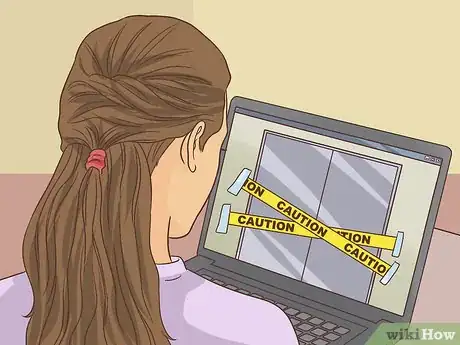This article was co-authored by Klare Heston, LCSW. Klare Heston is a Licensed Independent Clinical Social Worker based in Cleveland, Ohio. With experience in academic counseling and clinical supervision, Klare received her Master of Social Work from the Virginia Commonwealth University in 1983. She also holds a 2-Year Post-Graduate Certificate from the Gestalt Institute of Cleveland, as well as certification in Family Therapy, Supervision, Mediation, and Trauma Recovery and Treatment (EMDR).
There are 10 references cited in this article, which can be found at the bottom of the page.
This article has been viewed 79,912 times.
You might feel nervous around elevators, but that doesn't mean you have to resign yourself to taking the stairs forever. Whether you have mild claustrophobia or severe anxiety about getting stuck, you can learn to conquer your fear of elevators. There's no rush—work through the process at your own pace until you feel more comfortable. And remember, you're not in this alone! Our guide has tons of tips to help you manage your anxiety about elevators.
Steps
Expert Q&A
-
QuestionI have a fear of elevators (it started when I was 5), but my dad promised me the gaming laptop I have been saving up for if I go. Should I do it?
 Klare Heston, LCSWKlare Heston is a Licensed Independent Clinical Social Worker based in Cleveland, Ohio. With experience in academic counseling and clinical supervision, Klare received her Master of Social Work from the Virginia Commonwealth University in 1983. She also holds a 2-Year Post-Graduate Certificate from the Gestalt Institute of Cleveland, as well as certification in Family Therapy, Supervision, Mediation, and Trauma Recovery and Treatment (EMDR).
Klare Heston, LCSWKlare Heston is a Licensed Independent Clinical Social Worker based in Cleveland, Ohio. With experience in academic counseling and clinical supervision, Klare received her Master of Social Work from the Virginia Commonwealth University in 1983. She also holds a 2-Year Post-Graduate Certificate from the Gestalt Institute of Cleveland, as well as certification in Family Therapy, Supervision, Mediation, and Trauma Recovery and Treatment (EMDR).
Licensed Social Worker It sounds like your fear is long-standing. Please consider re-reading the WikiHow article, "Deal With a Fear of Riding in Elevators." There are a lot of good ideas there. Try to sort through your fear with some of the questions in the article. If necessary, sort your fear through with a therapist. Believe that you can overcome it!!
It sounds like your fear is long-standing. Please consider re-reading the WikiHow article, "Deal With a Fear of Riding in Elevators." There are a lot of good ideas there. Try to sort through your fear with some of the questions in the article. If necessary, sort your fear through with a therapist. Believe that you can overcome it!! -
QuestionIf I am stuck in elevator and lights of the elevator are switched off, what should I do then? And whenever I go by lift I have fear of the lift getting stuck between floors. What should I do?
 Klare Heston, LCSWKlare Heston is a Licensed Independent Clinical Social Worker based in Cleveland, Ohio. With experience in academic counseling and clinical supervision, Klare received her Master of Social Work from the Virginia Commonwealth University in 1983. She also holds a 2-Year Post-Graduate Certificate from the Gestalt Institute of Cleveland, as well as certification in Family Therapy, Supervision, Mediation, and Trauma Recovery and Treatment (EMDR).
Klare Heston, LCSWKlare Heston is a Licensed Independent Clinical Social Worker based in Cleveland, Ohio. With experience in academic counseling and clinical supervision, Klare received her Master of Social Work from the Virginia Commonwealth University in 1983. She also holds a 2-Year Post-Graduate Certificate from the Gestalt Institute of Cleveland, as well as certification in Family Therapy, Supervision, Mediation, and Trauma Recovery and Treatment (EMDR).
Licensed Social Worker Having the lights go out probably adds to the fear about being stuck in an elevator. Use the light on your phone to illuminate the elevator buttons. See if there is a panic (red) button, or a phone number to call. If not, call 911.
Having the lights go out probably adds to the fear about being stuck in an elevator. Use the light on your phone to illuminate the elevator buttons. See if there is a panic (red) button, or a phone number to call. If not, call 911.
References
- ↑ http://www.helpguide.org/articles/anxiety/phobias-and-fears.htm
- ↑ http://www.anxietycare.org.uk/docs/self.asp
- ↑ http://www.sciencefocus.com/feature/fear/how-overcome-your-fears-4-steps
- ↑ http://www.helpguide.org/articles/anxiety/phobias-and-fears.htm
- ↑ http://anxietynetwork.com/content/coping-statements-anxiety
- ↑ http://articles.latimes.com/2011/dec/15/news/la-heb-elevator-safety-death-201112115
- ↑ https://www.verywell.com/what-is-the-fear-of-elevators-2671765
- ↑ http://www.dir.ca.gov/dosh/elevatorfaq.html
- ↑ http://www.everydayhealth.com/columns/health-answers/what-is-the-easiest-way-to-experience-the-benefits-of-meditation/













































































Medical Disclaimer
The content of this article is not intended to be a substitute for professional medical advice, examination, diagnosis, or treatment. You should always contact your doctor or other qualified healthcare professional before starting, changing, or stopping any kind of health treatment.
Read More...